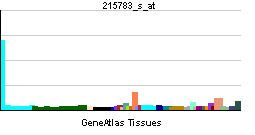Entrez 249 | Ensembl ENSG00000162551 | |
 | ||
Aliases ALPL, AP-TNAP, APTNAP, HOPS, TNAP, TNSALP, alkaline phosphatase, liver/bone/kidney External IDs MGI: 87983 HomoloGene: 37314 GeneCards: ALPL | ||
Alkaline phosphatase, tissue-nonspecific isozyme is an enzyme that in humans is encoded by the ALPL gene.
There are at least four distinct but related alkaline phosphatases: intestinal, placental, placental-like, and liver/bone/kidney (tissue-nonspecific). The first three are located together on chromosome 2, whereas the tissue-nonspecific form is located on chromosome 1. The product of this gene is a membrane-bound glycosylated enzyme that is not expressed in any particular tissue and is, therefore, referred to as the tissue-nonspecific form of the enzyme. The exact physiological function of the alkaline phosphatases is not known. A proposed function of this form of the enzyme is matrix mineralization. However, mice that lack a functional form of this enzyme show normal skeletal development. This enzyme has been linked directly to a disorder known as hypophosphatasia, a disorder that is characterized by hypercalcemia and includes skeletal defects. The character of this disorder can vary, however, depending on the specific mutation, since this determines age of onset and severity of symptoms.
